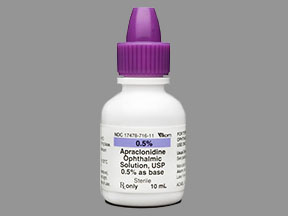
Apraclonidine Coupons & Savings Card – Discount Prices from $51.74
Generic for: Iopidine
My prescription
Edit
10ML of 0.5%, Apraclonidine (1 Bottle)
Select pharmacy

CVS
$52.46
COUPON PRICE
Walgreens
$51.74
COUPON PRICE
Walmart
$111.94
COUPON PRICE
Albertsons
$139.84
COUPON PRICEApraclonidine savings card
Show this card to your pharmacist
Walgreens
$51.74
BIN
ID
PCN
GRP
015995
LHFC695892
GDC
GDRX
Powered by
More prescriptions for glaucoma
More prescriptions for glaucoma
Price history for Iopidine (brand) & Apraclonidine (generic)
1 Bottle, 10ML of 0.5%
Average retail price for Iopidine
Average retail price for Apraclonidine
Average SaveHealth price for Apraclonidine
Our price history data is based on aggregated prescription data collected from participating pharmacies in America. Our prescription data updates daily to reflect the latest price changes. If you notice a missing data point, it means there wasn't sufficient data available to generate a monetary value for that date.
We analyzed Apraclonidine prices for (10ML of 0.5%, 1 Bottle) over the last 12 months. The average retail price was $368.11, while the average price using the SaveHealth discount card was $111.66. That's a savings of approximately 69.67% when using our Apraclonidine coupon.
Compared to the generic version, Iopidine had an average price of $1175.92 over the same time period. With the SaveHealth savings card, Apraclonidine is 90.50% cheaper on average than Iopidine.
*Retail prices are based on pharmacy claims data, and may not be accurate when we don't have enough claims.
Apraclonidine dosage forms
Dosage Quantity Price from Per unit 10ML of 0.5% 1 Bottle $52.46 $52.46 10ML of 0.5% 2 Bottles $94.62 $47.31 10ML of 0.5% 3 Bottles $128.78 $42.93
| Dosage | Quantity | Price from | Per unit |
|---|---|---|---|
| 10ML of 0.5% | 1 Bottle | $52.46 | $52.46 |
| 10ML of 0.5% | 2 Bottles | $94.62 | $47.31 |
| 10ML of 0.5% | 3 Bottles | $128.78 | $42.93 |
Apraclonidine Warnings
The following safety information outlines crucial risks and precautions associated with using this medication. Please read carefully and discuss any concerns with your healthcare provider.
Liver and Kidney Concerns: Apraclonidine, though applied to the eyes, may enter the bloodstream, potentially accumulating in individuals with liver or kidney issues. If you have such conditions, inform your doctor, as monitoring of blood pressure and heart rate may be necessary.
Low Blood Flow Complications: The medication might lower blood pressure, which could exacerbate conditions involving inadequate blood flow to the brain, heart, extremities, or other areas. If you suffer from high blood pressure, severe heart conditions, recent heart attacks, previous strokes, kidney failure, Raynaud's disease, or Buerger's disease, notify your healthcare provider.
Dizziness and Drowsiness: This medication may cause dizziness or drowsiness. Avoid driving or engaging in activities that require full alertness until you understand how apraclonidine affects you.
Allergic Reactions: Some individuals may experience allergic reactions, including redness, itching, discomfort, tearing, or swelling of the eyes or eyelids. Contact your healthcare provider if these symptoms occur.
Contraindications
This medication should not be used if you have any of the following conditions, as it could lead to serious health issues. Consult your healthcare professional if you are:
- Taking monoamine oxidase inhibitors (MAOIs).
- Allergic to apraclonidine or clonidine.
Always follow your healthcare provider's advice and report any adverse effects you experience while using this medication.
Apraclonidine Side Effects
Common side effects:
- eye discomfort
- redness
- itching
- dry mouth
- blurred vision
- eye inflammation
- dry eye
- sensation of something in the eye
- changes to eyelid
- tearing
Less common but important to monitor:
- irregular or abnormal heartbeat
- mood changes
- mental changes
- irritability
- depression
Serious side effects:
- severe allergic reaction
- rash
- significant itching or swelling
- severe dizziness
- trouble breathing
Apraclonidine Interactions
Interactions with high risk of serious adverse effects and should be avoided:
- MAO inhibitors (isocarboxazid, Linezolid, Metaxalone, methylene blue, moclobemide, phenelzine, procarbazine, Rasagiline, safinamide, Selegiline, Tranylcypromine)
Interactions with moderate risk that may require dose adjustment, closer monitoring, or timing changes:
- Iobenguane I 131
Interactions with low risk that usually do not require a change in therapy:
- Alcohol
- Marijuana (cannabis)
- Antihistamines (Cetirizine, diphenhydramine)
- Sleep or anxiety medications (Alprazolam, Diazepam, Zolpidem)
- Muscle relaxants
- Opioid pain relievers (codeine)
